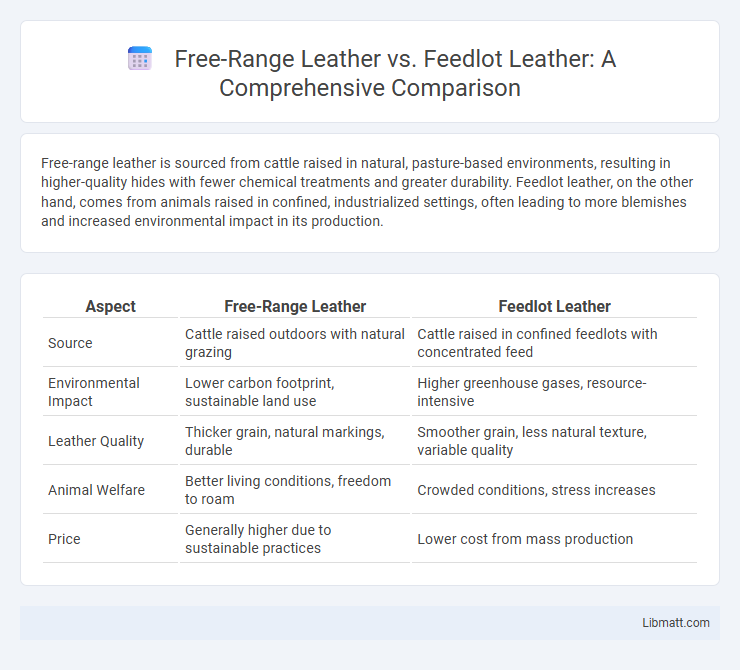Free-range leather is sourced from cattle raised in natural, pasture-based environments, resulting in higher-quality hides with fewer chemical treatments and greater durability. Feedlot leather, on the other hand, comes from animals raised in confined, industrialized settings, often leading to more blemishes and increased environmental impact in its production.
Table of Comparison
| Aspect | Free-Range Leather | Feedlot Leather |
|---|---|---|
| Source | Cattle raised outdoors with natural grazing | Cattle raised in confined feedlots with concentrated feed |
| Environmental Impact | Lower carbon footprint, sustainable land use | Higher greenhouse gases, resource-intensive |
| Leather Quality | Thicker grain, natural markings, durable | Smoother grain, less natural texture, variable quality |
| Animal Welfare | Better living conditions, freedom to roam | Crowded conditions, stress increases |
| Price | Generally higher due to sustainable practices | Lower cost from mass production |
Introduction to Free-range and Feedlot Leather
Free-range leather comes from cattle raised in open pastures with natural grazing, resulting in thicker, more durable hides with unique grain patterns. Feedlot leather originates from cattle confined in intensive feedlots, where animals are fed a controlled diet for faster growth, often producing smoother but less resilient leather. The difference in raising methods directly impacts leather quality, texture, and environmental sustainability.
Key Differences in Animal Rearing Practices
Free-range leather comes from animals raised in open pastures with natural grazing, promoting better animal welfare and healthier hides. In contrast, feedlot leather is sourced from animals confined in crowded feedlots, where their diet is controlled and often grain-based, which can affect skin quality. Understanding these differences helps you choose leather products that align with ethical and quality standards.
Environmental Impact: Free-range vs Feedlot Leather
Free-range leather typically results in a lower environmental impact due to more sustainable grazing practices that preserve soil health and biodiversity, reducing deforestation and greenhouse gas emissions compared to feedlot leather. Feedlot leather production often involves concentrated animal feeding operations (CAFOs), which contribute significantly to land degradation, water pollution, and higher methane emissions. The extensive resource use and waste generation in feedlots contrast sharply with the more ecologically balanced approach of free-range systems, highlighting the environmental benefits of free-range leather.
Animal Welfare Considerations
Free-range leather typically comes from animals raised with greater access to natural environments, promoting better overall welfare through increased movement and reduced stress. Feedlot leather often originates from animals confined in high-density, industrial conditions where limited space and higher stress levels can negatively impact their well-being. Choosing free-range leather supports more ethical treatment of animals by prioritizing humane living conditions and minimizing intensive confinement.
Leather Quality: Texture and Durability
Free-range leather typically offers superior texture and durability due to the natural environment and diet of the animals, which promote healthier skin and fewer imperfections. Feedlot leather often shows more uniformity but can be prone to weaker fibers and inconsistencies caused by confined living conditions and stress. Your choice can impact the longevity and feel of leather goods, with free-range leather generally providing a richer, more resilient material.
Chemical Treatments and Tanning Processes
Free-range leather typically undergoes vegetable tanning, which uses natural tannins derived from plants, reducing exposure to harmful chemicals compared to feedlot leather often processed with chromium tanning, a method involving toxic substances such as chromium salts. Vegetable tanning results in more environmentally friendly leather that is biodegradable and free from heavy metals, while feedlot leather's chromium tanning enhances durability and water resistance but poses environmental risks due to chemical runoff. The choice between these tanning processes significantly impacts the leather's environmental footprint, chemical residues, and potential health effects.
Traceability and Transparency in Sourcing
Free-range leather offers superior traceability and transparency in sourcing due to its more regulated and open farming practices, allowing consumers to verify animal welfare and environmental standards. Feedlot leather often lacks detailed sourcing information, as intensive farming methods prioritize volume over accountability, making it harder to track the entire supply chain. Your choice of leather can impact ethical consumption by supporting traceable and transparent production methods found in free-range sourcing.
Market Demand and Pricing Analysis
Free-range leather commands a premium in the market due to its sustainable sourcing and superior craftsmanship, attracting environmentally conscious consumers willing to pay higher prices. Feedlot leather, while more affordable, caters to mass-market demand with consistent supply but often faces criticism over ethical concerns, influencing its pricing competitiveness. Your choice between the two impacts both the cost and market appeal of leather products, reflecting growing trends in consumer preferences toward sustainability.
Sustainability Certifications and Standards
Free-range leather often carries sustainability certifications such as the Leather Working Group (LWG) and the Global Organic Textile Standard (GOTS), which ensure environmentally responsible tanning and livestock management practices. In contrast, feedlot leather may lack these certifications due to higher environmental impacts, including increased greenhouse gas emissions and intensive resource consumption. Adherence to sustainability standards in free-range leather production promotes biodiversity, better animal welfare, and reduced chemical use, making it a preferable option for eco-conscious consumers.
Choosing Ethically: Consumer Considerations
Consumers prioritizing ethical leather should consider the environmental impact and animal welfare practices associated with free-range leather versus feedlot leather. Free-range leather typically involves cattle raised in natural grazing conditions, resulting in a more sustainable and humane option compared to feedlot leather, which often comes from intensive, confined feeding operations. Understanding these differences helps you make informed choices that align with your values for ethical sourcing and ecological responsibility.
Free-range leather vs feedlot leather Infographic

 libmatt.com
libmatt.com